Abstract
A role for Zn2+ in a variety of neurological conditions such as stroke, epilepsy and Alzheimer's disease has been postulated. In many instances, susceptible neurons are located in regions rich in Zn2+ where nerve growth factor (NGF) levels rise as a result of insult. Although the interaction of Zn2+ with this neurotrophin has previously been suggested, the direct actions of the ion on NGF function have not been explored. Molecular modeling studies predict that Zn2+ binding to NGF will induce structural changes within domains of this neurotrophin that participate in the recognition of TrkA and p75NTR. We demonstrate here that Zn2+ alters the conformation of NGF, rendering it unable to bind to p75NTR or TrkA receptors or to activate signal transduction pathways and biological outcomes normally induced by this protein. Similar actions of Zn2+ are also observed with other members of the NGF family, suggesting a modulatory role for this metal ion in neurotrophin function.
This is a preview of subscription content, access via your institution
Access options
Subscribe to this journal
Receive 12 print issues and online access
$209.00 per year
only $17.42 per issue
Buy this article
- Purchase on Springer Link
- Instant access to full article PDF
Prices may be subject to local taxes which are calculated during checkout
Similar content being viewed by others
References
Smart, T.G., Xie, X. & Krishek, B.J. Modulation of inhibitory and excitatory amino acid receptor ion channels by zinc. Prog. Neurobiol. 42, 393–441 (1994).
Xie, X. & Smart, T.G. A physiological role for endogenous zinc in rat hippocampal synaptic neurotransmission. Nature 349, 521–524 (1991).
Bush, A.I. et al. Rapid induction of Alzheimer Aβ amyloid formation by zinc. Science 265, 1464–1467 (1993).
Harrison, N.L. & Gibbons, S.J. Zn2+: An endogenous modulator of ligand- and voltage-gated ion channels. Neuropharmacology 33, 935–952 (1994).
Koh, J.-Y. et al. The role of zinc in selective neuronal death after global cerebral ischemia. Science 272, 1013–1016 (1996).
Lindvall, O., Kokaia, Z., Bengzon, J., Elmér, E. & Kokaia, M. Neurotrophins and brain insults. Trends Neurosci. 17, 490–499 (1994).
Levi-Montalcini, R. The nerve growth factor 35 years later. Science 237, 1154–1162 (1987).
Frade, J.M., Rodríguez-Tébar, A. & Barde, Y.-A. Induction of cell death by endogenous nerve growth factor through its p75 receptor. Nature 383, 166–168 (1996).
Casaccia-Bonnefil, P., Carter, B.D., Dobrowsky, R.T. & Chao, M.V. Death of oligodendrocytes mediated by the interaction of nerve growth factor with its receptor p75. Nature 383, 716–719 (1996).
Van der Zee, C.E.E.M., Ross, G.M., Riopelle, R.J. & Hagg, T. Survival of cholinergic forebrain neurons in developing p75NGFR-deficient mice. Science 274, 1729–1732 (1996).
Chao, M.V. & Hempstead, B.L. p75 and Trk: A two-receptor system. Trends Neurosci. 18, 321–326 (1995).
McDonald, N.Q. et al. A new protein fold revealed by the 2.3Å resolution crystal structure of nerve growth factor. Nature 354, 411–414 (1991).
Holland, D.R., Cousens, L.S., Meng, W. & Mathews, B.W. Nerve growth factor in different crystal forms displays structural flexibility and reveals zinc binding sites. J. Mol. Biol. 238, 385–400 (1994).
Bradshaw, R.A. et al. Nerve growth factor: Structure/function relationships. Protein Science 3, 1901–1913 (1994).
Ibáñez, C.F. Neurotrophic factors: From structure-function studies to designing effective therapeutics. Trends Biotech. 13, 217–227 (1995).
Shih, A., Laramee, G.R., Schmelzer, C.H., Burton, L.E. & Winslow, J.W. Mutagenesis identifies amino-terminal residues of nerve growth factor necessary for trk receptor binding and biological activity. J. Biol. Chem. 269, 27679–27686 (1994).
Shamovsky, I.L., Ross, G.M., Riopelle, R.J. & Weaver, D.F. Theoretical studies on the bioactive conformation of nerve growth factor using VBMC — A novel variable basis Monte Carlo simulated annealing algorithm for peptides. J. Am. Chem. Soc. 118, 9743–9749 (1996).
Ibáñez, C.F. et al. Disruption of the low affinity receptor-binding site in NGF allows neuronal survival and differentiation by binding to the trk gene product. Cell 69, 329–341 (1992).
Woo, S.B. & Neet, K.E. Characterization of histidine residues essential for receptor binding and activity of nerve growth factor. J. Biol. Chem. 271, 24433–24441 (1996).
Greene, L.A. & Tischler, A.S. Establishment of a noradrenergic clonal cell line of rat pheochromocytoma cells which respond to nerve growth factor. Proc. Natl. Acad. Sci. USA 73, 2424–2432 (1976).
Kaplan, D.R., Matin-Zanca, D. & Parada, L.F. Tyrosine phosphorylation and tyrosine kinase activity of the trk proto-oncogene product induced by NGF. Nature 350, 158–160 (1991).
Kaplan, D.R., Hempstead, B.L., Martin-Zanca, D., Chao, M.V. & Parada, L.F. The trk proto-oncogene product: a signal transducing receptor for nerve growth factor. Science 252, 554–558 (1991).
Zhang, D. et al. Atrolysin C. Protein Data Bank (Brookhaven National Laboratory, Upton, NY), accession code 1ATL.
Sarkar, B. Peptide models for the metal-binding sites of proteins and enzymes. J. Indian Chem. Soc. 59, 1403–1411 (1982).
Vedani, A., Huhta, D.W. & Jacober, S.P. Metal coordination, H-bond network formation, and protein-solvent interactions in native and complexed human carbonic anhydrase I: A molecular mechanics study. J. Am. Chem. Soc. 111, 4075–4081 (1989).
Argos, P., Garavito, R.M., Eventoff, W. & Rossmann, M.G. Similarities in active center geometries of zinc-containing enzymes, proteases and dehydrogenases. J. Mol. Biol. 126, 141–158 (1978).
Kochoyan, M., Keutmann, H.T. & Weiss, M.A. Alternating zinc fingers in the human male-associated protein ZFY: HX3H and HX4H motifs encode a local structural switch. Biochemistry 30, 9396–9402 (1991).
Green, L.M. & Berg, J.M. A retroviral Cys-Xaa2-Cys-Xaa4-His-Xaa4-Cys peptide binds metal ions: Spectroscopic studies and a proposed three-dimensional structure. Proc. Natl, Acad. Sci. USA 86, 4047–4051 (1989).
Bertini, I., Luchinat, C. & Scozzafava, A. Carbonic anhydrase: An insight into the zinc binding site and into the active cavity through metal substitution. in: Structure and Bonding, Vol. 48, 45–92 (Springer-Verlag, Berlin-Heidelberg, 1982).
Tainer, J.A., Getzoff, E.D., Beem, K.M., Richardson, J.S. & Richardson, D.C. Determination and analysis of the 2Å structure of copper, zinc superoxide dismutase. J. Mol. Biol. 160, 181–217 (1982).
Vallee, B.L. & Auld, D.S. Active-site zinc ligands and activated H2O of zinc enzymes. Proc. Natl. Acad. Sci. USA 87, 220–224 (1990).
Sheridan, R.P. & Alien, L.C. The active site electrostatic potential of human carbonic anhydrase. J. Am. Chem. Soc. 103, 1544–1550 (1981).
Cunningham, B.C., Mulkerrin, M.G. & Wells, J.A. Dimerization of human growth hormone by zinc. Science 253, 545–548 (1991).
Somers, W., Ulsch, M., De Vos, A.M. & Kossiakoff, A.A. The X-ray structure of a growth hormone-prolactin receptor complex. Nature 372, 478–481 (1994).
Matthews, D.J. & Wells, J.A. Engineering an interfacial zinc site to increase hormone-receptor affinity. Chem. Biol. 1, 25–30 (1994).
Dostaler, S.M. et al. Characterization of a distinctive motif of the low molecular weight neurotrophin receptor that modulates NGF-mediated neurite growth. Eur. J. Neurosci. 8, 870–879 (1996).
Rylett, R.J. & Williams, L.R. Role of neurotrophins in cholinergic-neurone function in the adult and aged CNS. Trends Neurosci. 17, 486–490 (1994).
Ben-Ari, Y. & Represa, A. Brief seizure episodes induce long-term potentiation and mossy fibre sprouting in the hippocampus. Trends Neurosci. 13, 312–318 (1990).
Rashid, K. et al. A nerve growth factor peptide retards seizure development and inhibits neuronal sprouting in a rat model of epilepsy. Proc. Natl. Acad. Sci. USA 92, 9495–9499 (1995).
Lewin, G.R. & Mendell, L.M. Nerve growth factor and nociception. Trends Neurosci. 16, 353–359 (1993).
Woolf, C.J. & Doubell, T.A. The pathophysiology of chronic pain — increased sensitivity to low threshold Aβ-fibre inputs. Curr. Opin. Neurobiol. 4, 525–534 (1994).
McMahon, S.B., Bennett, D.L.H., Priestley, J.V. & Shelton, D.L. The biological effects of endogenous nerve growth factor on adult sensory neurons revealed by a trkA-IgG fusion molecule. Nature Med. 1, 774–780 (1994).
Hancock, R.D. & Martell, A.E. Ligand design for selective complexation of metal ions in aqueous solutions. Chem. Rev. 89, 1875–1914 (1989).
Gregory, D.S., Martin, A.C.R., Cheetham, J.C. & Rees, A.R. The prediction and characterization of metal binding sites in proteins. Protein Eng. 6, 29–35 (1993).
Brooks, B.R. et al. CHARMM: A program for macromolecular energy, minimization, and dynamics calculations. J. Comput. Chem. 4, 187–217 (1983).
Dent, A.J., Beyersmann, D., Block, C. & Hasnain, S.S. Environment of zinc sites in 5-aminoaevulinate dehydratase. Physica B 158, 95–96 (1989).
Robinson, R.C., Radziejewski, C., Stuart, D.I. & Jones, E.Y. Structure of the brain-derived neurotrophic factor/neurotrophin-3 heterodimer. Biochemistry 34, 4139–4146 (1995).
Sutter, A., Riopelle, R.J., Harris-Warrick, R.M. & Shooter, E.M. Nerve growth factor receptors. J. Biol. Chem. 254, 5972–5982 (1979).
Connolly, D.T., Knight, M.B., Harakas, N.K., Wittwer, A.J. & Feder, J. Determination of the number of endothelial cells in culture using an acid phosphatase assay. Anal. Biochem. 152, 136–140 (1986).
Ueda, Y., Walsh, E., Nakanishi, H. & Yoshida, K. A colorimetric assay method for the evaluation of neurotrophic activity in vitro . Neurosci. Lett. 165, 203–207 (1994).
Mesner, P.W., Winters, T.R. & Green, S.H. Nerve growth factor withdrawal-induced cell death in neuronal PC12 cells resembles that in sympathetic neurons. J. Cell Biol. 119, 1669–1680 (1992).
Batistatou, A. & Greene, L.A. Aurintricarbonic acid rescues PCI 2 cells and sympathetic neurons from cell death caused by nerve growth factor deprivation: Correlation with suppression of endonuclease activity. J. Cell Biol. 115, 461–471 (1991).
Rukenstein, A., Rydel, R.E. and Greene, L.A. Multiple agents rescue PC1 2 cells from serum-free cell death by translation- and transcription-independent mechanisms. J. Neurosci. 11, 2552–2563 (1991).
Greene, L.A. Nerve growth factor prevents the death and stimulates neuronal differentiation of clonal PC1 2 pheochromocytoma cells in serum-free medium. J. Cell Biol. 78, 747–755 (1978).
Author information
Authors and Affiliations
Rights and permissions
About this article
Cite this article
Ross, G., Shamovsky, I., Lawrance, G. et al. Zinc alters conformation and inhibits biological activities of nerve growth factor and related neurotrophins. Nat Med 3, 872–878 (1997). https://doi.org/10.1038/nm0897-872
Received:
Accepted:
Issue Date:
DOI: https://doi.org/10.1038/nm0897-872
This article is cited by
-
Covalent arylation of metallothionein by oxidized dopamine products: A possible mechanism for zinc-mediated enhancement of dopaminergic neuron survival
Neurotoxicity Research (2008)
-
Zinc inhibits p75NTR-mediated apoptosis in chick neural retina
Cell Death & Differentiation (2001)
-
Differential effects of transition metal cations on the conformation and biological activities of nerve growth factor
Neurotoxicity Research (2000)
-
Clioquinol-Zinc Chelate: A Candidate Causative Agent of Subacute Myelo-Optic Neuropathy
Molecular Medicine (1998)



